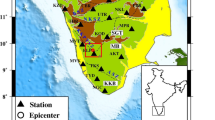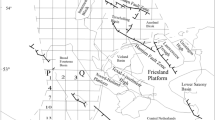Abstract
The joint modeling of the petrophysical properties (i.e., porosity, permeability) from wells in the presence of one or more seismic attributes (i.e., impedance) may be cumbersome, as the linear model of coregionalization needs to be simultaneously fitted to all experimental direct and cross-variograms, and the strong assumptions are required in the collocated cokriging system. Transforming each petrophysical property to an uncorrelated factor through the projection-pursuit multivariate transform allows each uncorrelated factor to be simulated independently. However, considering the case where there is an exhaustive secondary variable, the uncorrelated factors can no longer be simulated independently, as they are still conditionally dependent through the secondary variable. The aim of this paper is to provide a solution to this problem through the simulation of each uncorrelated factor in a subsequent fashion; that is, the first uncorrelated factor is cosimulated using the available secondary variable as a covariate; the second uncorrelated factor is cosimulated using a super-secondary variable generated by merging the previously simulated first uncorrelated factor and the secondary variable, and the kth uncorrelated factor is cosimulated using a super-secondary variable generated by merging all previously simulated uncorrelated factors \((1,\ldots ,k-1)\) as well as the secondary variable. This hierarchical simulation framework preserves the correlation structure between the uncorrelated factors themselves and between the uncorrelated factors and the secondary variable. The methodology is demonstrated in case studies using synthetic and real reservoir datasets. It is shown that the use of PPMT approach and the hierarchical simulation workflow in combination achieves: (1) multivariate complexity in the data is accounted for through the PPMT approach, and (2) the reproduction of the observed bivariate relationships in the simulated realizations of the petrophysical properties themselves and the secondary information is ensured by the hierarchical simulation workflow.
Highlights
-
Application of multivariate Gaussian transform to the spatially correlated variables.
-
Simulation of each factor independently.
-
Reproduction of the bivariate statistics in the realizations.









Similar content being viewed by others
References
Almeida, A. S., & Journel, A. G. (1994). Joint simulation of multiple variables with a Markov-type coregionalization model. Mathematical Geology, 26(5), 565–588.
Babak, O., & Deutsch, C. (2009a). An intrinsic model of coregionalization that solves variance inflation in collocated cokriging. Computers and Geosciences, 35(3), 603–614.
Babak, O., & Deutsch, C. V. (2009b). Collocated cokriging based on merged secondary attributes. Mathematical Geosciences, 41, 921–926.
Barnett, R. (2017a). Projection Pursuit Multivariate Transform. In Geostatistics Lessons.
Barnett, R. (2017b). Sphereing and min/max autocorrelation factors. In Deutsch, J. L. (Ed.), Geostatistics Lessons.
Barnett, R., & Deutsch, C. (2015). Linear rotations: Options for decorrelation and analysis. Technical report, CCG Annual Report 17, Edmonton, AB.
Barnett, R. M., Manchuk, J. G., & Deutsch, C. V. (2014). Projection pursuit multivariate transform. Mathematical Geosciences, 46(3), 337–359.
Barnett, R. M., Manchuk, J. G., & Deutsch, C. V. (2016). The projection-pursuit multivariate transform for improved continuous variable modeling. SPE Journal, 21(06), 2010–2026.
Caers, J. (2005). Petroleum geostatistics. Society of Petroleum Engineers.
Chilès, J. P., & Delfiner, P. (2012). Geostatistics: Modeling spatial uncertainty (2nd ed.). New York: Wiley.
Desbarats, A. J., & Dimitrakopoulos, R. (2000). Geostatistical Simulation of regionalized pore-size distributions using min/max autocorrelation factors. Mathematical Geology, 32(8), 919–942.
Deutsch, C. V., & Journel, A. G. (1998). GSLIB geostatistical software library and user’s guide (2nd ed.). New York: Oxford University Press.
Dubrule, O., & Damsleth, E. (2001). Achievements and challenges in petroleum geostatistics. Petroleum Geoscience, 7(S), S1–S7.
Dubrule, O., Thibaut, M., Lamy, P., & Haas, A. (1998). Geostatistical reservoir characterization constrained by 3D seismic data. Petroleum Geoscience, 4(2), 121–128.
Erten, O., & Deutsch, C. V. (2021). Assessment of variogram reproduction in the simulation of decorrelated factors. Stochastic Environmental Research and Risk Assessment.
Fournier, F. (1995). Integration of 3d seismic data in reservoir stochastic simulations: A case study. In SPE Annual Technical Conference and Exhibition. Society of Petroleum Engineers.
Goovaerts, P. (1993). Spatial orthogonality of the principal components computed from coregionalised variables. Mathematical Geology, 25(3), 281–302.
Hohn, M. (1998). Geostatistics and petroleum geology. Springer.
Johnson, R. A., & Wichern, D. W. (Eds.). (1988). Applied multivariate statistical analysis. Prentice-Hall.
Journel, A. G., & Huijbregts, C. J. (1978). Mining geostatistics. London: Academic Press.
Leuangthong, O., McLennan, J. A., & Deutsch, C. V. (2004). Minimum acceptance criteria for geostatistical realizations. Natural Resources Research, 13(3), 131–141.
Marechal, A. (1970). Cokrigeage et régression en correlation intrisèque. Technical report, Ecoledes Mines de Paris.
Mariethoz, G., & Caers, J. (2014). Multiple-point geostatistics: Stochastic modeling with training images. Wiley.
Pyrcz, M., & Deutsch, C. (2014). Geostatistical reservoir modelling (2nd edn.). Oxford University Press.
Qu, J., Manchuk, J. G., & Deutsch, C. V. (2018). Decorrelation (PCA/MAF/PPMT) in presence of secondary data. Technical report, CCG Annual Report 20, Edmonton, AB.
Santana Oliveira, C. A., Bassani, M. A. A., Costa, Coimbra Leite, & J. F. (2021). Application of covariance table for geostatistical modeling in the presence of an exhaustive secondary variable. Journal of Petroleum Science and Engineering,196, 108073.
Verly, G. W. (1993). Sequential Gaussian Cosimulation: A simulation method integrating several types of information. In A. Soares (Ed.), Geostatistics Tróia’92 chapter (Vol. 1, pp. 543–554). Springer.
Yao, T., & Journel, A. G. (2000). Integrating seismic attribute maps and well logs for porosity modeling in a west Texas carbonate reservoir: Addressing the scale and precision problem. Journal of Petroleum Science and Engineering, 28(1–2), 65–79.
Yarus, J. M., & Chambers, R. L. (2006). Practical geostatistics—an armchair overview for petroleum reservoir engineers. Journal of Petroleum Technology, 58(11), 78–86.
Zagayevskiy, Y., & Deutsch, C. V. (2016). Grid-free petroleum reservoir characterization with truncated pluri-Gaussian simulation: Hekla case study. Petroleum Geoscience, 22(3), 241–256.
Zhu, H., & Journel, A. (1993). Formatting and integrating soft data: Stochastic imaging via the Markov–Bayes algorithm. In A. Soares (Ed.), Geostatistics Tróia ’92 (pp. 1–12). Springer.
Acknowledgments
The authors thank the industrial sponsors of the Centre for Computational Geostatistics (CCG) for providing the resources to prepare this manuscript.
Author information
Authors and Affiliations
Corresponding author
Rights and permissions
About this article
Cite this article
Erten, O., Deutsch, C.V. Efficient Multivariate Property Modeling with Seismic Data. Nat Resour Res 30, 4107–4121 (2021). https://doi.org/10.1007/s11053-021-09915-4
Received:
Accepted:
Published:
Issue Date:
DOI: https://doi.org/10.1007/s11053-021-09915-4




